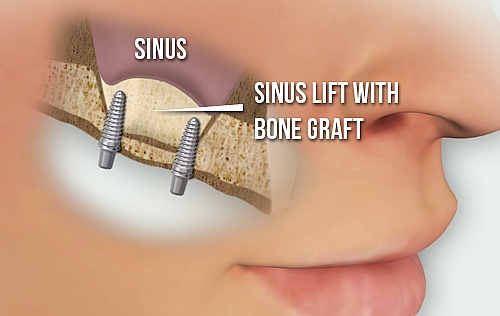Bone Graft Procedure
One of the most common side effects of

Tooth Socket After Extraction
Bone Graft and Socket Preservation
If a tooth is getting extracted, a specific type of bone graft called a socket preservation graft will be needed to replace the empty space where the tooth once was. Once you take a tooth out you’re left with a hole that needs to be filled in. A socket preservation graft will fill that hole.
Socket preservation is one type of bone graft for a dental implant. If you need a dental implant to replace an upper tooth, there may not be enough bone because the sinuses, the spaces above your upper jaw, are too large, leaving too small an area of bone to put an implant in. In that

Sinus Lift Bone Graft Adds Bone For A Dental Implant
Sinus Lift Bone Graft
The type of bone graft to add more bone to the upper jaw is called a sinus lift bone graft. The procedure “lifts” the bottom of the sinus so there
As you can see, a dental implant would not have enough bone to be stabilized without the grafted bone in the sinus lift.
If you need a dental implant in the lower jaw, a sinus lift bone graft is not possible. We don’t have sinuses in our lower jaws! So, another type of bone graft is needed to add bone to the lower jaw to stabilize dental implants.
If socket preservation grafts and small amounts of particulate bone grafts are not enough to add enough bone to the lower jaw, a larger bone graft will be needed. Large pieces of bone, not small particles, added, or grafted, to the lower jaw are called block grafts. Block grafts are larger blocks of bone that are physically attached to the jaw bone. After healing, the block graft becomes integrated
More Bone Graft Questions and Answers
At Great Lakes Dentistry in Royal Oak, Michigan, our dentists place dental implants using socket preservation and bone grafts to place dental implants. Our dentists also
A bone graft in Royal Oak is the process by which one of our knowledgeable dentists adds natural or synthetic bone tissue to your shrinking bone tissue to strengthen it and promote growth. A surgical treatment, bone grafting acts as a long-lasting solution to bone loss. If you would like more information on bone grafting, how it is completed, and what it can do for the future of your smile, please do not hesitate to call our friendly dental team at Great Lakes Dentistry today. Our goal is to help educate you about all of your treatment options so you can feel more confident in your dental


